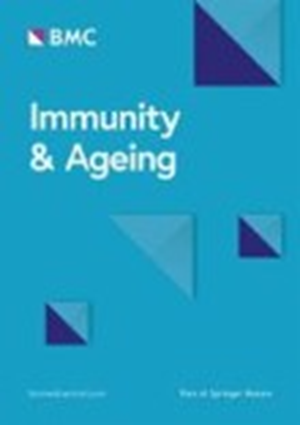Characterization of age-associated inflammasome activation reveals tissue specific differences in transcriptional and post-translational inflammatory responses
IF 5.6
2区 医学
Q1 GERIATRICS & GERONTOLOGY
引用次数: 0
Abstract
Aging is associated with systemic chronic, low-grade inflammation, termed ‘inflammaging’. This pattern of inflammation is multifactorial and is driven by numerous inflammatory pathways, including the inflammasome. However, most studies to date have examined changes in the transcriptomes that are associated with aging and inflammaging, despite the fact that inflammasome activation is driven by a series of post-translational activation steps, culminating in the cleavage and activation of caspase-1. Here, we utilized transgenic mice expressing a caspase-1 biosensor to examine age-associated inflammasome activation in various organs and tissues to define these post-translational manifestations of inflammaging. Consistent with other studies, we observe increased inflammation, including inflammasome activation, in aged mice and specific tissues. However, we note that the degree of inflammasome activation is not uniformly associated with transcriptional changes commonly used as a surrogate for inflammasome activation in tissues. Furthermore, we used a skull thinning technique to monitor central nervous system inflammasome activation in vivo in aged mice and found that neuroinflammation is significantly amplified in aged mice in response to endotoxin challenge. Together, these data reveal that inflammaging is associated with both transcriptional and post-translational inflammatory pathways that are not uniform between tissues and establish new methodologies for measuring age-associated inflammasome activation in vivo and ex vivo.与年龄相关的炎症小体激活特征揭示了转录和翻译后炎症反应的组织特异性差异
衰老与全身慢性低度炎症有关,被称为 "炎症衰老"。这种炎症模式是多因素的,由包括炎症小体在内的多种炎症途径驱动。然而,尽管炎症小体的激活是由一系列翻译后激活步骤驱动的,并最终导致 caspase-1 的裂解和激活,但迄今为止的大多数研究都是研究与衰老和炎症相关的转录组的变化。在这里,我们利用表达caspase-1生物传感器的转基因小鼠研究了不同器官和组织中与年龄相关的炎症小体激活,以确定炎症的这些翻译后表现。与其他研究一致,我们观察到老年小鼠和特定组织的炎症增加,包括炎症小体活化。不过,我们注意到,炎症小体的激活程度与通常作为组织中炎症小体激活替代物的转录变化并不一致。此外,我们还利用头骨削薄技术监测了老龄小鼠体内中枢神经系统炎性体的激活情况,并发现老龄小鼠的神经炎症在应对内毒素挑战时会显著放大。这些数据共同揭示了炎症与转录和翻译后炎症通路有关,这些通路在不同组织之间并不一致,并建立了测量体内外年龄相关炎性体活化的新方法。
本文章由计算机程序翻译,如有差异,请以英文原文为准。
求助全文
约1分钟内获得全文
求助全文
来源期刊

Immunity & Ageing
GERIATRICS & GERONTOLOGY-IMMUNOLOGY
CiteScore
10.20
自引率
3.80%
发文量
55
期刊介绍:
Immunity & Ageing is a specialist open access journal that was first published in 2004. The journal focuses on the impact of ageing on immune systems, the influence of aged immune systems on organismal well-being and longevity, age-associated diseases with immune etiology, and potential immune interventions to increase health span. All articles published in Immunity & Ageing are indexed in the following databases: Biological Abstracts, BIOSIS, CAS, Citebase, DOAJ, Embase, Google Scholar, Journal Citation Reports/Science Edition, OAIster, PubMed, PubMed Central, Science Citation Index Expanded, SCImago, Scopus, SOCOLAR, and Zetoc.
 求助内容:
求助内容: 应助结果提醒方式:
应助结果提醒方式:


